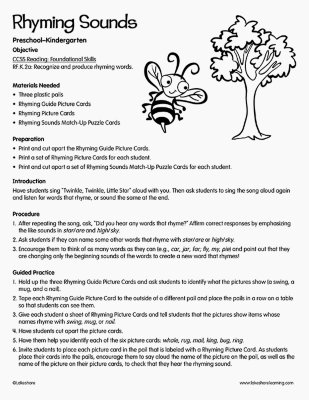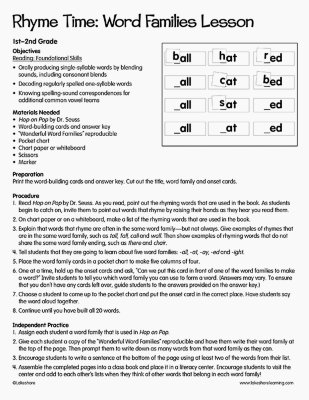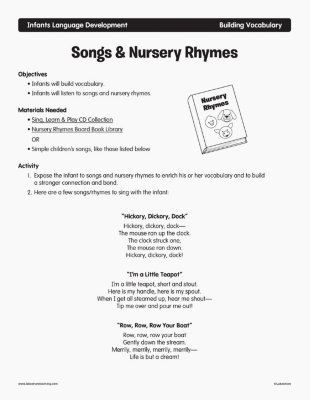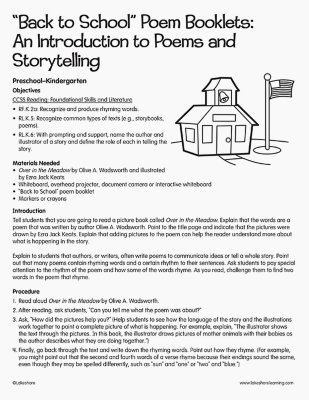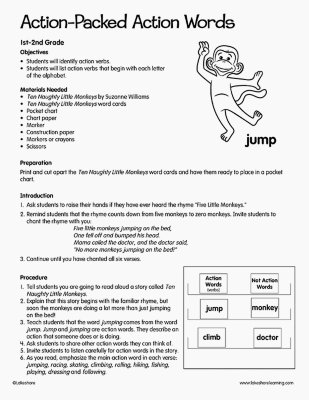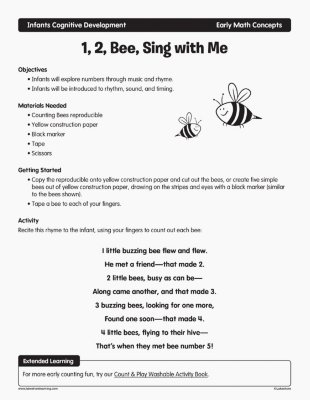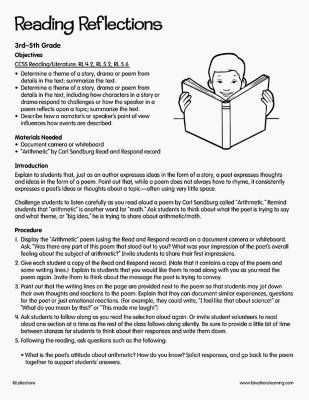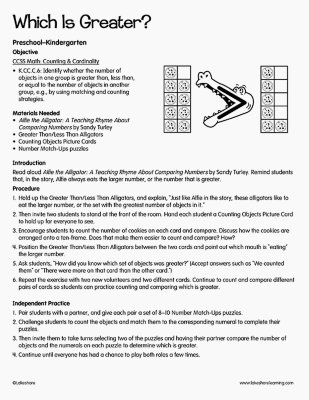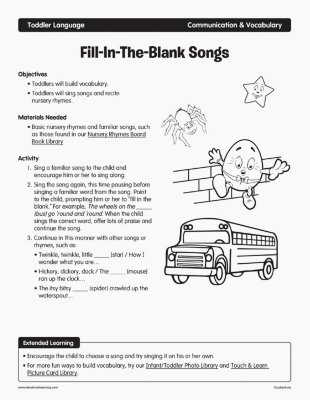Narrow by Grade
Grade
9 results for "rhyming/"
Rhyming Sounds
Pre-K - Kindergarten
Objective CCSS Reading: Foundational Skills RF.K.2a: Recognize and produce rhyming words. Materials Needed Three plastic pails Rhyming Guide Picture Cards Rhyming Picture Cards Rhyming Sounds Match-Up Puzzle Cards Introduction Have students sing “Twinkle, Twinkle, Little Star” aloud with you. Then ask students to sing the song aloud again and listen for words that rhyme, or sound the same at the end.
View Lesson PlanRhyme Time: Word Families Lesson
1st Grade - 2nd Grade
Objectives Reading: Foundational Skills Orally producing single-syllable words by blending sounds, including consonant blends Decoding regularly spelled one-syllable words Knowing spelling-sound correspondences for additional common vowel teams Materials Needed Hop on Pop by Dr. Seuss Word-building cards and answer key “Wonderful Word Families” reproducible Pocket chart Chart paper or whiteboard Scissors Marker Preparation Print the word-building cards and answer key. Cut out the title, word family and onset cards.
View Lesson PlanSongs & Nursery Rhymes
Infant
Objectives
• Infants will build vocabulary.
• Infants will listen to songs and nursery rhymes.
"Back to School" Poem Booklets: An Introduction to Poems and Storytelling
Kindergarten
Objectives Recognizing common types of texts (e.g., storybooks, poems) Naming the author and illustrator of a story and defining the role of each in telling the story Recognizing and producing rhyming words Materials Needed Over in the Meadow by Olive A. Wadsworth with illustrations by Ezra Jack Keats Whiteboard, overhead projector, document camera or interactive whiteboard “Back to School” poem booklet Crayons Introduction Tell students that you are going to read a picture book called Over in the Meadow. Explain that the words are a poem that was written by author Olive A. Wadsworth. Point to the title page and indicate that the pictures were drawn by Ezra Jack Keats. Explain that adding pictures to the poem can help the reader understand more about what is happening in the story. Explain to students that authors, or writers, often write poems to communicate ideas or tell a whole story. Point out that many poems contain rhyming words and a certain rhythm to their sentences. Ask students to pay special attention to the rhythm of the poem and how some of the words rhyme. As you read, challenge students to find two words in the poem that rhyme.
View Lesson PlanAction-Packed Action Words
1st Grade
Objectives Students will identify action verbs. Students will list action verbs that begin with each letter of the alphabet. Materials Needed Ten Naughty Little Monkeys by Suzanne Williams Ten Naughty Little Monkeys Word Cards Pocket chart Chart paper Marker Construction paper Markers or crayons Scissors Preparation: Print and cut apart the Ten Naughty Little Monkeys word cards and have them ready to place in a pocket chart. Introduction Ask students to raise their hands if they have ever heard the rhyme “Five Little Monkeys.” Remind students that the rhyme counts down from five monkeys to zero monkeys. Invite students to chant the rhyme with you: Five little monkeys jumping on the bed, One fell off and bumped his head. Mama called the doctor, and the doctor said, “No more monkeys jumping on the bed!” Continue until you have chanted all six verses.
View Lesson Plan1, 2, Bee, Sing with Me
Infant
Objectives
• Infants will explore numbers through music and rhyme.
• Infants will be introduced to rhythm, sound, and timing.
Reading Reflections
5th Grade
Objectives CCSS Reading/Literature: RL.4.2, RL.5.2, RL.5.6 Determine a theme of a story, drama or poem from details in the text; summarize the text. Determine a theme of a story, drama or poem from details in the text, including how characters in a story or drama respond to challenges or how the speaker in a poem reflects upon a topic; summarize the text. Describe how a narrator’s or speaker’s point of view influences how events are described. Materials Needed Document camera or whiteboard “Arithmetic” by Carl Sandburg Read and Respond record Introduction Explain to students that, just as an author expresses ideas in the form of a story, a poet expresses thoughts and ideas in the form of a poem. Point out that, while a poem does not always have to rhyme, it consistently expresses a poet’s ideas or thoughts about a topic—often using very little space. Challenge students to listen carefully as you read aloud a poem by Carl Sandburg called “Arithmetic.” Remind students that “arithmetic” is another word for “math.” Ask students to think about what the poet is trying to say and what theme, or “big idea,” he is trying to share about arithmetic/math.
View Lesson PlanWhich Is Greater?
Kindergarten
Objective CCSS Math: Counting & Cardinality K.CC.C.6: Identify whether the number of objects in one group is greater than, less than, or equal to the number of objects in another group, e.g., by using matching and counting strategies. Materials Needed Alfie the Alligator: A Teaching Rhyme About Comparing Numbers by Sandy Turley Greater Than/Less Than Alligators Counting Objects Picture Cards Number Match-Ups puzzles Introduction Read aloud Alfie the Alligator: A Teaching Rhyme About Comparing Numbers by Sandy Turley. Remind students that, in the story, Alfie always eats the larger number, or the number that is greater.
View Lesson PlanFill-In-The-Blank Songs
Toddler
Objectives
• Toddlers will build vocabulary.
• Toddlers will sing songs and recite nursery rhymes.
